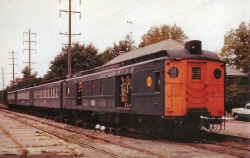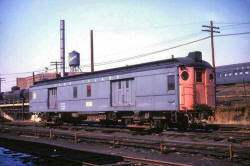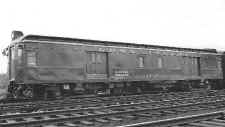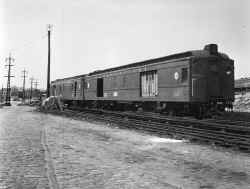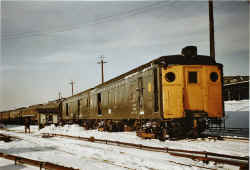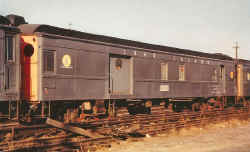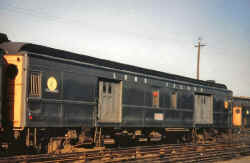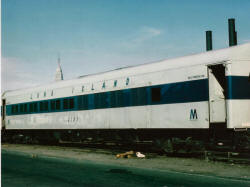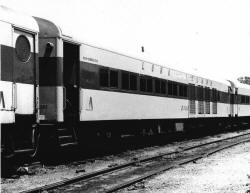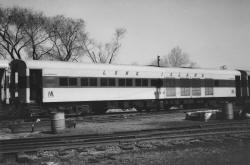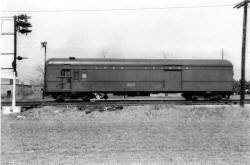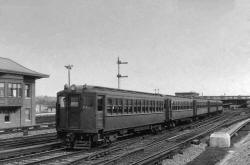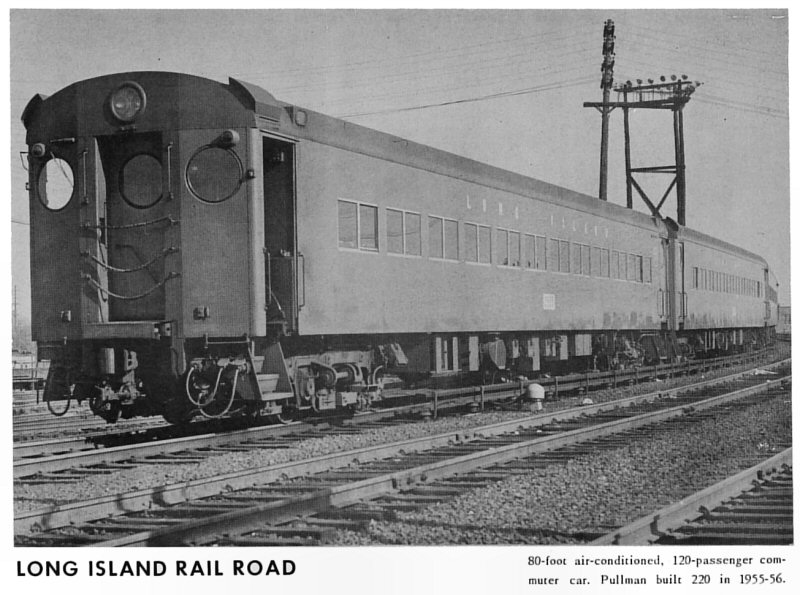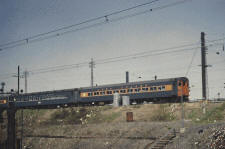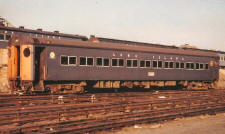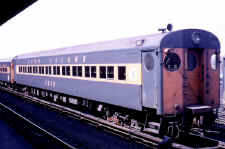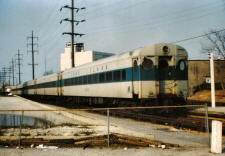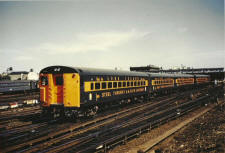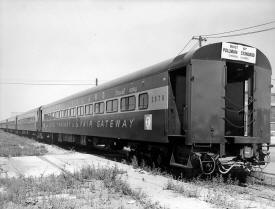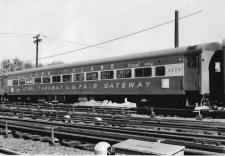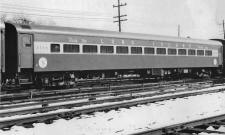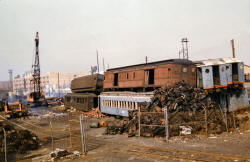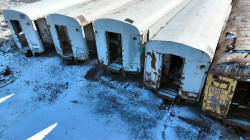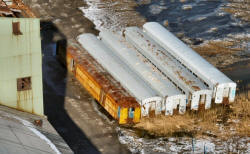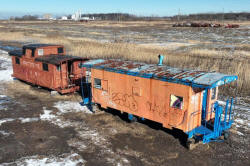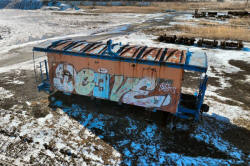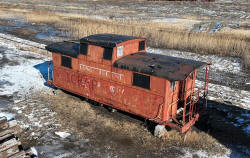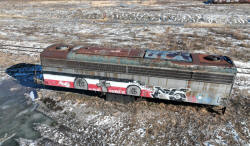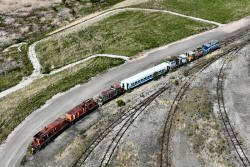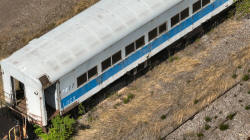|
|
||||
|
Here's a very faded Tuscan Red MB62 leading an MP72C and either a MP72T or a T72 into Jamaica. On the right, leaving Jamaica, are a MP54B or MP54C and another arch roofed "54", both in the later "Tichy" paint scheme with Brunswick Green (?), or black, roofs. The first MP72C cars were built 7/1955, the first MP72T cars 8/1955 and the first T72 cars 10/1955. Since the trees are bare and the sun is low in the sky this is probably late 1955 or early 1956. Info: Jeff Erlitz Collection: Bill J. Madden A MB62, or for that matter, any LIRR MU in Tuscan Red,
and a pretty badly faded TR, is quite a surprise if not an anomaly as the
Tichy paint scheme came into being in November 1949. And yet, five
or six years later, there's still a car in Tuscan Red with gold lettering!
|
||||
| WOODEN | BUILDER | DATES | DATA | All retired by 1927 |
| Club Cars | Pullman | 1892 |
24 parlor cars built by Pullman in 1892 with 6-wheel trucks and 58'-5" inches in length with 30 revolving seat. In 1913 to 1915, 770, 771, 773 and 774--originally referred to as "Club Cars"-- were converted to regular coaches and then sold to Georgia Car & Locomotive Co. 12/1925 Research: Vincent Seyfried 1917 LIRR roster--it's invaluable as both steel and wood passenger cars as well as freight cars. Parlor and Club cars 770 to 802 were on the roster with 29 cars available in this group and less than 70 feet long. Mike Boland
|
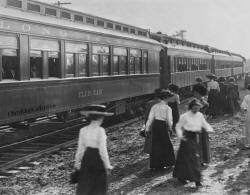 Pratt Institute students and faculty arrive at Medford Station May 17, 1910. This was a special train, with Club Car #770, organized to attend a picnic in the area. Photo: Hal B. Fullerton Archive: Queens Public Library |
| Parlor Car | Pullman | 1902 | #789-796 Eight vestibule 6-wheel
trucks Length: 78'-8"; 41 revolving seats; all converted to coaches after 1911-1916 #789 Sold to Georgia Company: 6/1927
Many of these late-model wooden parlor cars were converted by the LIRR to
coaches, probably as the LIRR purchased its own new steel cars built by ACF
and ultimately replaced its wooden car fleet to go all-steel in 1927. |
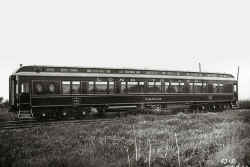 Wooden Pullman Parlor Car #789 1902 Archive: Dave Keller |
| Victorian Coaches | Wason Manufacturing Co. | 1899 | 30 coaches #229-258 65' length seats 72 sold #230, 231, 236, 239 to Georgia Car & Locomotive Co. 7/1927 |
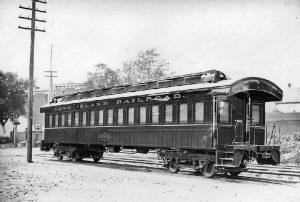 LIRR #236 Archive: Dave Keller |
| T39 | Wason Manufacturing Co. | 1899 | 30 wooden-trailer cars #877-906 built for Jamaica-Brooklyn Bridge service. Rebuilt in Morris Park Shops 1905 for use as trailers with MP41 cars. Discontinued use 12/17/1914 and sold 1917. |
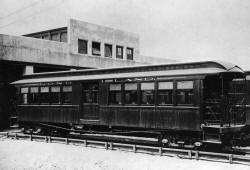 #892 1899 - Dunton Car Shops Archive: Jeff Erlitz |
| MB45 | Wason Manufacturing Co. | 1905 | 5 MU Wood Baggage 1200-1204 Sold
1917 to Washington, Baltimore & Annapolis RR
|
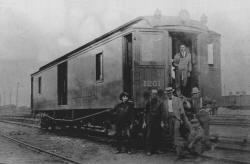 LIRR MB45 #1201 Collection of Electric Railroaders’ Assoc, Inc Archive: Jeff Erlitz |
| Combine baggage/passenger | Pullman Palace Car Co. | 1898 | #501-520 sold 1926 to Georgia Car & Loco Co. | 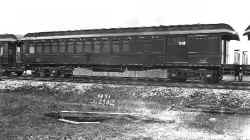 LIRR #505 builder photo 1898 |
| Private Business Car | Jackson & Sharp | 1885 |
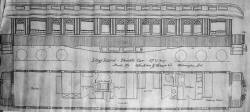 MANHATTAN private business car diagram
|
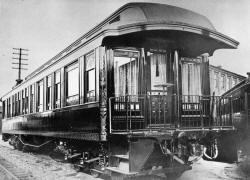 Austin Corbin's private business car "MANHATTAN"
|
| Open Vestibule Coach | Jackson & Sharp | 1890 |
|
|
| Closed Vestibule | Jackson & Sharp, AC&F |
1898 | Last
wooden car produced for LIRR 1898 |
|
| Day Coach | Jackson & Sharp | 1899 | In 1876 Jackson & Sharp received a Centennial Award at the Philadelphia Centennial Exhibition, in the “railway plant, rolling stock, engines” category for its passenger, boudoir, and library cars. LIRR received in 1899. | |
|
|
||||
| SPECIAL CARS | BUILDER | DATES | DATA | |
|
Hospital Car |
1898-1910 |
Coach #117 Destroyed by fire 8/20/1910
|
||
| Superintendent’s Car | Pullman | 1902-1909 | ||
| Jackson & Sharp | 1906-1935-8? | |||
| E-6 Open Air Car | Used for Beach runs | |||
| Gas Electric Scoots | ||||
| Electric/Storage/Battery | Edison Electric | 1911-1926 | ||
| Brill Gas Car | J. G Brill Company | 1914-1926 |
|
|
| Trolley Car | ||||
|
|
||||
| |
||||
| B74a | Pullman | Horse Express Cars: The numbering of B-74a was changed from 5551-5555, 5561-5565,
and 5766-5775 to 5800-5819 at the time the names were applied. Over the years various names were applied to the cars.
Capacity 24 horses; two stalls on each side of the three doors. |
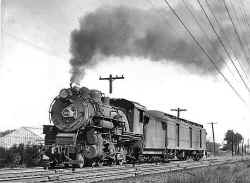 LIRR #143 - Hicksville - Horse express car Class B74a 1947 Archive: Dave Keller |
|
| B74b | Pullman | #5820-5869
|
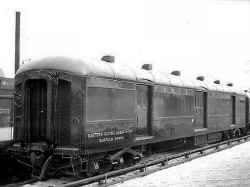 PRR B74b Horse express car - "Eastern Racing Association Suffolk Downs" Massachusetts. This is an example of Horse Car class B74b also used on the LIRR. Info: Dave Keller |
|
| The PRR horse cars were class B74a/b. From the outside they looked like baggage cars except they had 3 doors per side and a pair of stalls on either side of the doors to transport twenty-four horses maximum. The PRR named all the cars; Atlantic City Racing Association, Aqueduct, Dell Mar Turf Club, Metropolitan Jockey Club, etc. | 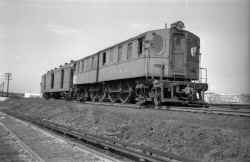 DD1 #340 in Tichy Scheme - PRR B74b horse express car "Brandywine Stables" near Jamaica 1950 Archive: Dave Keller |
|||
|
|
||||
| DOUBLE DECKER | BUILDER | DATES | DATA | |
|
Double-decker 200, the original double-decker built by the PRR and ALCOA in 1932, was a trailer and always classed as T62. It is the only double-decker that has survived in Riverhead on RMLI grounds. Double-deckers 1287 through 1346 were originally control motors all built by PRR Altoona Shops 1947-1949. MP70B 1287-1289, and 1291 converted to motor trailers
class MP70BT in the late 1950's. MP70B 1290, 1292-1333 remained as control motors with
ASC. It's very possible that, along with the MP54's, those cars that eventually became motor trailers operated in mid-train service without speed control after ASC was introduced in June 1951 and operated this way for a number of years before they "officially" were converted to motor trailers and were probably "buried" in the middle of train consists. All those motor trailers, while considered motor trailers after conversion, may not have had all their controls removed; some may have kept them for yard moves, where ASC was not necessary. These cars also kept their headlights, marker lights, and even kept their storm or end doors with the glass window; they were simply painted over along with their porthole windows. Built in 1937, MP70 1347, originally a four-motor
double-decker intended to operate as a "married pair" with CT70 201 (see
photo below). This unit was the only double-decker with four motors and
apparently was not given ASC in 1951, becoming a MP70T motor trailer. Sometime later, probably in the late
1950's, the motors were removed, becoming a trailer class T70. Unlike 201,
it kept its headlights and they were painted over. CT70 201, a
control trailer, also built in 1937, had its controls and headlights removed
in the late 1950's and also became a T70. |
||||
| T62 | 1932 | 200 The first double decker car
built by PRR and ALCOA, lacking both motors and controls, but was also the FIRST ALL
ALUMINUM railroad car produced. Info: Dave Keller It is the only double-decker that has survived in Riverhead, NY on RMLI grounds.
|
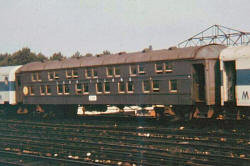 LIRR #200 double decker 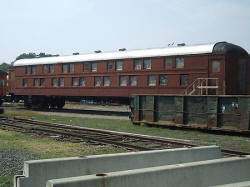 LIRR #200 RMLI-Riverhead 8/26/2007 |
|
| T70 | 1937 | 201 | 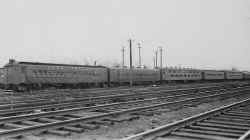 The railroad's fleet of pre-war doubledeckers in the years before the post-war fleet of 60 cars began to arrive in 1947. Double-deckers #201 and #1347 at Babylon Yard with MP54A #1418 and MP54C #1728 on March 8, 1947. Photo: George Votava Archive: Mike Boland |
|
| T70A | 1947 | 202-205 | ||
| MP70 | 1937 |
1347 Delivered to be the only MP70 with four motors.
|
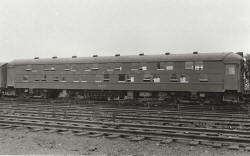 #1347 Morris Park Yard 7/09/1950 Photo: George Votava Archive: Mike Boland |
|
| MP70A | PRR-Juniata, 4/1947 | 1947 |
1337-1346
|
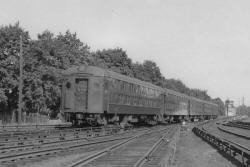 MP70A #1346 - Train #734 westbound Hempstead to Penn weekdays 9/16/1948 (Votava-Boland) |
| MP70Ac | Double-deckers fitted with ASC were denoted as MP70Ac and MP70Bc, the lower case "c" denoting Automatic Speed Control. |
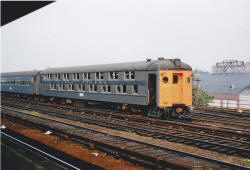 MP70Ac #1344 Yard D, Jamaica 5/30/1959 Photo: Bob's Photos |
||
| MP70B | 1948 1949 |
1287-1322 1323-1336 |
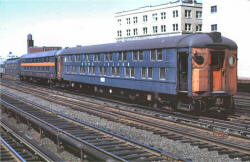 LIRR #1296 Union Hall St., Jamaica 7/12/1971 |
|
| MP70Bc | 1303, 1309 |
The "c" denoting speed
control (ASC).
In May of 1966 (I'm pretty sure of this date) it was ordered that Dashing
Dan was no longer to be used so |
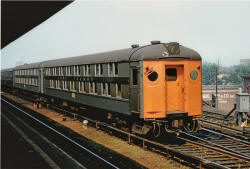 MP70Bc #1290 Yard D, Jamaica 5/30/1989 Photo: Bob's Photos |
|
| MP70T | Pullman | 1952-53 |
3500-3519 "Wyer cars" a nickname ordered by Trustee Wyer. The only cars delivered in the Tichy scheme with an attractive rounded blue stripe through their windows. Also referred to as "Cadillacs", sarcastically for their lack of amenities and "Back Breakers", for their uncomfortable fixed seats. Mike Boland |
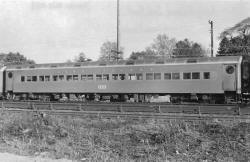 MP70T #3505 Babylon 5/15/1955 (Votava-Boland)
|
| C3 | Kawasaki | 1997- |
134 cars 23 Cab controlled cars |
|
|
|
||||
| BAGGAGE | BUILDER | DATES | DATA | |
| B40 | AC&F | 4-5/1914 | #651-670
|
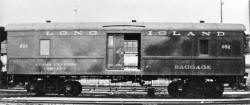 B40 #652 Archive: Art Huneke |
|
|
||||
| PASSENGER | BUILDER | DATES | DATA | |
| Starting in December of 1954, the LIRR began an extensive modernization program of all classes of equipment that included complete mechanical rebuilding, new interiors and new numbers to reflect the upgrading. The newly reworked cars were numbered into four number series: 4000 for control motors, 5000 for motor trailers, 6000 for MU trailers, and 7000 for steam coaches. | ||||
| BUS | Pullman Standard | 1950 | A five double bedroom buffet lounge observation car Chesapeake & Ohio 2502 TIDEWATER CLUB. Acquired by Baltimore & Ohio in 1951; redesignated B&O 7500 NAPPANEE. Assigned to the Capitol Limited. Acquired by LIRR in October 1968. AMAGANSETT. |
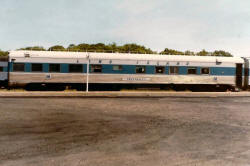 AMAGANSETT #2000 ex-B&O #7500 NAPPANEE Photo/Archive: Mike Boland Redesignated LIRR 2000 MORRIS PARK in 1976 after conversion to push-pull capability. Modified as a tunnel clearance car in 1990. Retired and sold to Roanoke Valley Central Railway in Salem, VA c.1999. Acquired by Blue Ridge Rail Restorations and stored in Salem VA. October 2008: Car has been moved and in Romney, WV on South Branch Valley RR/Potomac Eagle Scenic Railway. Research: John Deasy |
| P54 | American Car & Foundry | 1912 | Steam
Cars #139-178, were ex-PRR cars
|
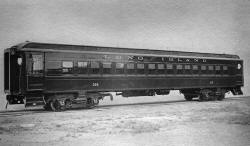 LIRR #316 Builders photo 5/1911 Archive: Jeff Erlitz Collection of Electric Railroaders’ Assoc, Inc This blueline print
illustrates the lettering arrangement for the following car classes: |
| P54A | American Car & Foundry | 1911-1914 |
#314-370 Scrapped at Holban Yard, 1952
|
|
| P54B |
American Car & Foundry | 1913-1918 | #379-388 | |
| P54D | American Car & Foundry |
6/1922 #422-431 1927 #1-138 |
74 cars
modernized starting 12/1954 and renumbered as part of 7000 series
(7002-7481, not all inclusive)
Referred to as "Ping
Pongs"
|
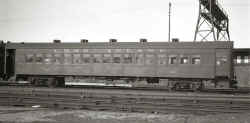 LIRR #433 Jamaica 11/27/32
|
| P58 | American Car & Foundry | 1/1907 | #179 Originally #1401:1 Built 1/1907 Renumbered #1451, 12/17/1907, to vacate #1401 for new electric multiple-unit cars on order. Converted into a club car 6/9/1925 with no number but named "SMITHTOWN" with individual wicker chairs facing the aisle replacing the coach seating. Used as club car weekdays during the summer season on rear of train #621 and head end of train #652. Converted back into a 72-seat coach, 10/1942, and renumbered #179. with rattan reversible coach seating replaced the wicker chairs. Withdrawn from revenue service 10/28/1949. Used as instruction car for Maintenance of Equipment personnel at Morris Park from 1949 to 1959. Stored from 1959 and scrapped: 11/1961 Research: Jeff Erlitz |
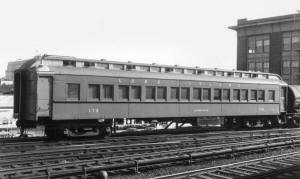 LIRR #179 Instruction car - Yard D, Jamaica |
| P69 | Osgood Bradley | 1925 |
Purchased from the D&H
8/1962 nos. 8517-8522 LIRR 8517-8520 ex-D&H 208-211 8521 ex-D&H 219 8522 ex-D&H 221 Note: 8518 built 1926 |
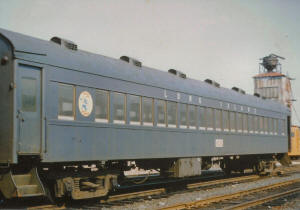 LIRR #8520 ex-D&H #211 (Lichenstern-Boland) |
| P70 | American Car & Foundry | 1911-1913 after 1926 converted to coaches after Pullman Extra Services Takeover | 808-826 | 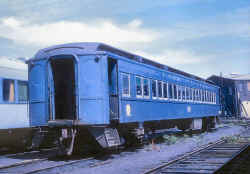 LIRR #824, former parlor car, Morris Park Yard 1962 Photo: William Rigen |
| P71 | Osgood Bradley | 1924 |
8506-8509 ex-MEC 218-221 84 seat coach Purchased LIRR: 6/1962 |
|
| P71A | Osgood Bradley | 1931 |
8510-8513 ex-MEC 262-265 68 seat coach All P71-P71A scrapped Naporano, Newark NJ between 5/1/969 and 5/14/1971 Jeff Erlitz |
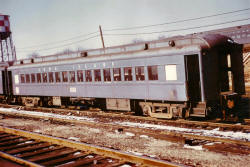 LIRR P71A #8513 - Receiving Yard 1/10/1969 Archive: Mike Boland |
| P72 | Pullman Standard | 1955-1956 |
Nos.
2901-2980 except
|
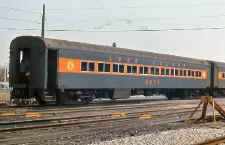 LIRR #2970 LI City 4/1970 Photo: Jim Parker 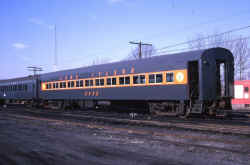 LIRR #2932 P72 - Port Jefferson 1965 Note: steam heat connector by air lines underneath coupler. Info: John Deasy The LIRR 2900 series P72 coaches all had their own power plants/generators for heat, lights and air conditioning which used diesel fuel. They were totally independent from locomotives. |
| P72 Bar | Pullman Standard | Rebuilt 1975 |
2990-2992,
former
2905, 2970, 2957 |
|
| P72A | Pullman Standard | 1955 | 2801-2844 | |
| P72G
/ Bar |
||||
| P73L | Pullman Standard | 1916 | Acquired from EL in September 1962.
Redesignated LIRR 2038 SETAUKET in May 1963 and operated as parlor lounge
observation until September 1968. Renumbered W-99 and reclassified as
business car in 1970. In 1971, renumbered as (2nd) 99 and renamed (2nd)
JAMAICA. Transferred to Maintenance of Equipment section. Last used
approximately 1975.
|
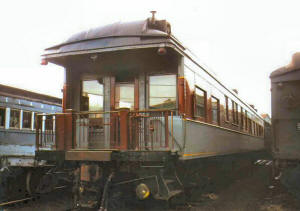 SETAUKET in EL colors - Jamaica 1/1963 Archive: Dave Keller |
| American Car & Foundry | 1912 | Converted to a coach (class PP70A)
after 1926. LIRR #815. Rebuilt to (open platform) business car LIRR #2000
MONTAUK 12/1925. Renamed JAMAICA as parlor observation car after 1957.
Withdrawn 1968 and stored until 1972.
Donated/displayed Wantagh Museum, NY 1972
|
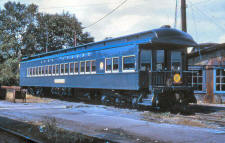 JAMAICA #2000 Class P73L - Richmond Hill 9/25/1960 Archive: Dave Morrison |
|
| P74A | Pullman Standard | 1924 | 2001-2003 | |
| P74B | Osgood Bradley - PS | 1935-37 |
Built for the Boston & Maine for general long-distance service. Cars #7521-7530 received: 9-10/1958 Cars #7531-7550 received: 1-8/1959 Research: Jeff Erlitz |
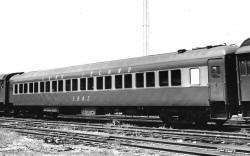 LIRR P74B #7547 (Votava-Boland) |
| P74B1 |
Osgood Bradley - PS
|
10/1937 |
Built for the BAR for buffet coach service. Cars:
#8551-8553 Purchased 6/1962. Modernized: 1/1963 Scrapped: 5/1973 8552:
9/13/1972 |
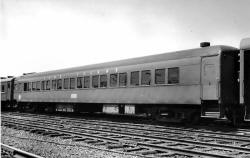 LIRR #8551 ex-BAR #150 (Votava-Boland) |
| P74D Parlor | Pullman
Standard HEAVYWEIGHT Parlor cars 6-wheel trucks |
1923-27 |
2013-2036
|
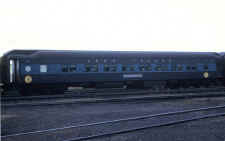 LIRR #2020 PATCHOGUE at Montauk Yard 05/15/66 (Rugen-Keller) |
| P74E | Pullman | 8/1911 | 8/1911 - Built new for the Lehigh
Valley by Pullman as baggage club car LV 1000. 1929 - Rebuilt by the LV to a full club car. 1939 - Rebuilt by the LV in 1939 for assignment to the "John Wilkes" 1953 - Rebuilt by the LV with 24 dining seats and 22 club seats. modernized with streamlined appearance. 1961 - Sold to LIRR, 8/16/1961. No. 2005 before being reassigned No. 2037, named TUSCARORA CLUB 3/1970 - Rebuilt to full parlor car in 3/1970 - Re-designated 2037 ONTEORA:2 Parlor car from 5/1970-9/1970 only 1/1974 - Retired and sold to private owner. Car is part of a restaurant complex American Flyer Café, Marietta, GA. 10/29/2008 - Sold at auction for $423 The car is scrapped in place, never moved from the restaurant in Marietta, GA. 11/2009 - Scrapped on location. Research: Jeff Erlitz LIRR #2037 TUSCARORA CLUB
at Montauk Yard
c.1964 |
|
| P80 | Budd, Pullman | 1946-48 | 13 cars 531-543 13 Steam Coach retired 1972 | Silver Streak Cars |
| P80 |
Budd Budd Pullman |
1947 1941 7-10/1946 |
529 ex-New York Central 2938 530 ex-New York Central 86-Samuel J. Tilden 531 ex-New York Central 3005 532 ex-New York Central 3049 533 ex-New York Central 3063 534 ex-New York Central 3067 535 ex-New York Central 3073 536 ex-New York Central 3075 537 ex-New York Central 3064 538 ex-New York Central 3101 539 ex-New York Central 3126 540 ex-New York Central 3133 541 ex-New York Central 3136 542 ex-New York Central 3147 543 ex-New York Central 314 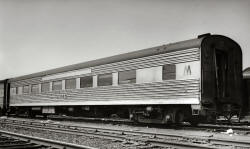 LIRR #541 coach ex-NYC #3136 at Richmond Hill. 5/26/1968 Photo: Gene Collora Archive: Mike Boland |
NYC sold c.6/1967
to Pickens RR. rebuilt. LIRR purchase 10-11/1967. Car #86 Samuel J. Tilden
purchased 12/1967. Named “Pickens cars” by MOE Dep't 'Silver Streak'
by everyone else.
|
| P80A Parlor | Pullman Standard | 1939-40 | 13 cars 2051-2063 Acquired in 1968 Retired 1975-76 | |
| 2051 Pantigo 2052 Patchogue 2053 Peconic 2054 Ponquogue 2055 Wantagh 2056 Wauwepex 2057 Wickapogue 2058 Wunneweta 2059 Napeague 2060 Nesconset 2061 Noyack 2062 Wyandanch 2063 Poquott |
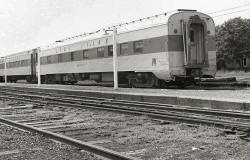 POQUOTT #2063 Parlor Shelter Island Express Greenport 8/1971 Photo/Archive: Dave Keller
|
|||
|
|
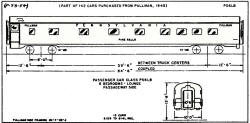 LIRR Class P80A Pullman Standard 1939 6 double bedroom buffet lounge passageway side |
|||
| P80B | Pullman Standard for Louisiana and Arkansas, a KCS subsidiary. | 1948 | Former KCS, ex-L&A, 14 roomette 4 double
bedroom sleeper acquired September 1968 utilized in LIRR East-end parlor
service: 2048 MANHASSET ex-KCS JOB EDSON 2049 MASSAPEQUA ex-KCS LEONORE LOREE 2050 MASTIC ex-KCS WILLIAM EDENBORN Repainted in spring/summer 1971 to LIRR colors. Retired 1975. Sold to Tuman Demolition Company; scraped 1976. |
_small.jpg) ex-KCS "Job Edson" at Babylon Station - 10/24/68 Photo/Archive: Dave Keller |
|
The ex-L&A car "Job Edson" is LI 2048, one of three ex-L&A
cars built by Pullman in 1948 and bought by LI in August, 1968, and assigned
LI class P80B. LI numbers were applied immediately to vestibules only. Built
as 24-seat 14-roomette 4-double bedroom cars. The others were "Leonore
Loree" which became LI 2049, and "William Edenborn" which became LI 2050. |
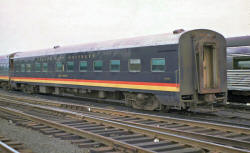 ex-KCS "Job Edson" at Richmond Hill 5/1969 Photo/Archive: Bill Mangahas |
|||
| P80C | American Car & Foundry | 1940-1948 | Former KCS coaches 251-266
renumbered: 8554 ex-KCS 251 8555 " 252 8556 " 253 8557 " 254 8558 " 255 8559 " 256 8560 " 257 8561 " 258 8562 " 259 8563 " 261 8564 " 262 8565 " 263 8566 " 264 8567 " 265 8568 " 266 8573 " 260 Note: The gap between 8569 and 8572 used to number the Florida East Coast coaches, class P80D, with names and not numbers. Mike Boland |
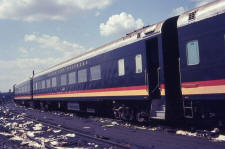 ex-KCS #265 coach - Richmond Hill Storage Yard 1968 Archive: Dave Keller
|
| P80D | Budd | 1946 |
Sold to the LIRR 1/1969 repainted 1970 coaches. Retired 1974. 8569 Boynton 8570 Homestead 8571 Bunnell 8572 Titusville (retained name) |
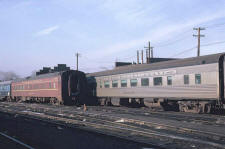 ex-FEC BOYNTON - Richmond Hill 1/1969 (Gillin-Deasy)
|
| Budd | 5/1947 | LIRR 1/1969, retired 9/1975 sold
1976 Operated in its FEC paint scheme until being repainted, relettered, and renumbered 'APAQUOGUE' #2064 6/9/1971. Used as a lounge-observation car on parlor CANNONBALL car trains. |
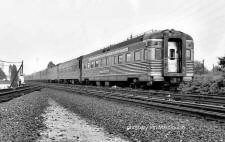 ex-FEC "LAKE OKEECHOBEE" 1969 used as a CANNONBALL parlor to Montauk. Photo/Archive: Jim Mardiguian |
|
| P80E | ACF | 1907 | 1st #1451 converted to Private Club
car "SMITHTOWN" and converted back into a
72-seat coach, 10/1942, and renumbered #179.
|
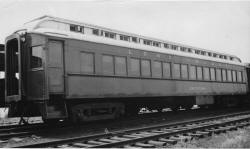 P80E Class Private Club Car "SMITHTOWN" ex-1451 Photo: Bill Lichenstern Archive: Mike Boland Note: Aluminum painted roof
and Futura Lettering |
| P80E | Pullman Standard | 12/1949-1/1950
1/1950 |
Cars transferred to Penn Central 2/1/1969, sold to Long Island 9/1969. Operated in New Haven/Penn Central colors for 1970 summer season. Cars repainted, renumbered, renamed and diaphragms replaced with safety chains on various dates, as follows: Cars 2069 and 2080 never had their roofs repainted from New Haven/Penn Central black to platinum mist. Car 2074 was never painted Long Island; it was kept at Morris Park for use as a parts car for the others. Car 2080 never had Long Island painted on letterboards. Research: Jeff Erlitz | |
| 2065 ex-NYNH&H 512-Manomet Point -
Mattinicock:2 2066 ex-NYNH&H 520-Race Point - Mattituck:2 2067 ex-NYNH&H 525-Stratford Point - Mecox 2068 ex-PC 4223-City Point, nee-NYNH&H 503-City Point - Merrick:2 2069 ex-NYNH&H518-Pond Point - Mineola:2 2070 ex-NYNH&H 506-Goshen Point - Montauk:3 2071 ex-PC 4229-Long Point, nee-NYNH&H 509-Long Point - Moriches:2 2074 ex-NYNH&H 532-Nantasket Beach - parts at Morris Park 2075 ex-NYNH&H 536-Monument Beach - Sagtikos:2 2076 ex-NYNH&H 527-Bailey’s Beach - Salonga 2077 ex-NYNH&H 529-Grove Beach - Sebonac 2078 ex-NYNH&H 531-Matunuck Beach - Setauket:2 2079 ex-NYNH&H 528-Crescent Beach - Shinnecock:2 2080 ex-NYNH&H 535-Rocky Neck Beach - Speonk |
|
|||
 1971 LIRR parlor/sleeping car fleet - NH #2074-#2080 Beach Series - Archive: Mike Boland
|
||||
| P80F | American Car & Foundry | 1949 | No. 2073 “TUCKAHOE” | |
| P80G | Budd | 1949 | Nos.
2081-2082
|
|
| P80H | American Car & Foundry | 1949 |
Nos. 2180-2185 Sold to MTA 1971, transferred to
LIRR 5/1974. Only 2182 and 2194 repainted LIRR. |
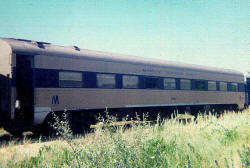 LIRR #2181 ex-DL&W, El, PC coach Photo/Archive: Tim Darnell
|
| P80J | Pullman Standard | 1949 | Nos. 2186-2194 | |
|
|
||||
| COMBINE | BUILDER | DATES | DATA | |
| PB54 | American Car & Foundry | 1911 | 5 cars #619-623 steel
|
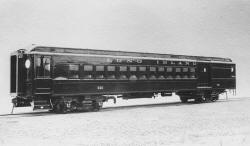 LIRR PB54 #621 c.10/1911 Builders photo Electric Railroaders’ Association, Inc. Archive: Jeff Erlitz |
| PB54A | 1914 | 3 cars #624-626 steel | ||
| PB54B | 1917 | #627 steel | ||
| PB57 | American Car & Foundry | 10/1927 | 609-618
Modernized 10/1958 and renumbered #7614 Scrapped 9/13/1972 by Naporano Iron and Metal Company, Newark NJ Note the "Futura" lettering which was considered VERY modern for 1939-40. Info: Jeff Erlitz |
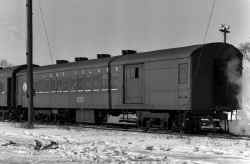 LIRR #7613 PB57 combine Oyster Bay Photo: R. Glueck 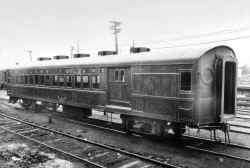 LIRR #7614 Richmond Hill Coach Yard c.1940 Archive: Jeff Erlitz |
|
|
||||
| RDC | BUILDER | DATES | DATA | |
| Budd | 1955- 1967 | Sold 12/71 | ||
|
|
||||
| MOTORIZED/PASSENGER | BUILDER | DATES | DATA | |
|
“M” designating the unit to be a “motor” or powered control cab and the
“P” meaning “passenger”, while the “54” was the length of the car,
bulkhead to bulkhead. As an aside, an MU baggage car was an “MPB54”
because it was powered, it carried passengers AND it carried baggage.
However, the electrics were MP54 or T54 units (“T” meaning trailer;
non-powered). And some of the OLDER, original purchase MP54 units had
clerestory roofs and not the famous arched roofs. MP54 means Motor/Passenger car which is 54' long. (there were also "blind motors" which were MP54 cars with no windshields and which were placed within the consist of a train to provide additional power to assist the lead MP54 which was NOT blind. Sort of like a steam locomotive coupled in the middle of a freight train with no view of the road ahead, positioned only to assist the lead steam locomotive(s) in hauling the train.
MPB54 means Motor/Passenger/Baggage car which is 54' long (known as a "combine car.")
MP-54 Rail Classics Jan.1981 article by Mike Boland |
||||
| MP54 | American
Car & Foundry
|
1908 |
30 cars 1421-1450 20 cars 1401-1420 MP54A MP54 was the first 30 cars 1421 through 1450 built by ACF at its Jackson and Sharp (merged into ACF) plant in Delaware in 1908.
|
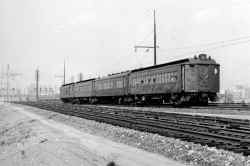 |
| A four-car MU train eastbound apparently headed for Port Washington in the late 1930's. The second car east is a trailer and note the combine at the rear(!) of the train. Many MP54's and MP54A's had large headlight housings replace their original small headlights while retaining their destination lights, seen on both sides of the headlight. These were removed in later years. At this time LIRR passenger fleet wore Tuscan Red with black roof and gold lettering. Photo: George Votava Archive: Mike Boland | ||||
|
|
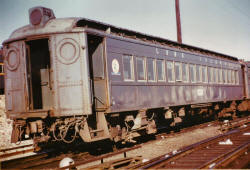 MP54 #1428 as trailer at Dunton 4/28/1968 Archive: Mike Boland |
|||
| MP54A |
American Car & Foundry | 1908 1909 |
20
cars 1401-1420 226 cars 1451-1676
|
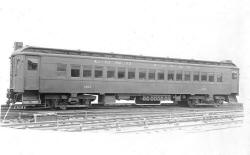 MP54A #1403 Photo: ACF c.1923 Archive: Hagley Library Some minor changes were made to the cars and the next class of 20 cars was MP54A built by ACF in Berwick, PA and numbered 1401 through 1420 and built beginning in 1909. 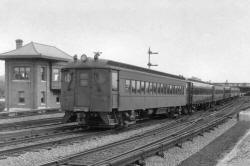 MP54A #1660 Built by ACF 1914 passing JAY Tower c.1915 Archive: Jeff Erlitz |
|
|
|
|||
|
MP54A #1405 outside the Dunton Car Shop on May 12, 1940. This was an order of 20 cars built by ACF and had minor differences from the 30 MP54 fleet of cars built in 1908, a year earlier. Photo: George Votava Archive: Mike Boland |
||||
|
MP54A #1505 has new safety glass windows with aluminum frames. Note the trailer behind this control motor, built in 1910 and scrapped in January 1956. This car, and many others had their controls and headlights removed and ran off their last years as motor trailers in mid-train service. Rockaway Park c.1940's. Photo: George Votava Archive: Mike Boland |
||||
|
MP54A #1474 leads a train with a car behind it in the new Tichy paint scheme. This car had no Automatic Speed Control (ASC) installed so this photo must have been taken prior to 1951. The car was scrapped August 1955. Archive: Mike Boland |
||||
The clerestory roof MP54 and MP54A cars, when rebuilt
as motor trailers, were given class MP54T and MP54AT and were renumbered
beginning with #1001 (an old MP41 number), #1002, #1003, etc. but this
renumbering ended after after #1017 and the cars kept their original
numbers. A few trailers were given power trucks and put into this class,
also. |
||||
| MP54A1 | Pressed
Steel Car Co. (25 cars) & American
Car & Foundry (20 cars) split car order between the LIRR and
another PRR subsidiary, West Jersey and Seashore. These 45 cars, and the 40 P54D's converted and motorized in 1930 (MP54D1 1944 through 1983) were the last MP54's built for the LIRR. |
1928-1930 | 45
cars 1135-1179 |
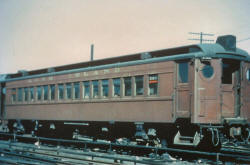 MP54A1 #1163, possibly Jamaica area, in Tuscan Red livery mid-1950's. This may have been the last car in this paint scheme. Archive: Mike Boland |
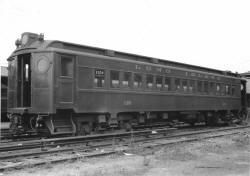 MP54A1 #1159 at Port Washington 4/05/1937 (Votava-Boland) |
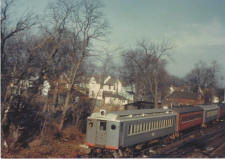 MP54A1 at the east end of an MU train in Babylon Early 1950's. (Harold Fagerberg-Mike Boland) |
|||
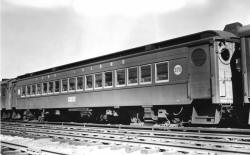 MP54A1 #4160 at Babylon 4/21/1963 (Votava-Boland) |
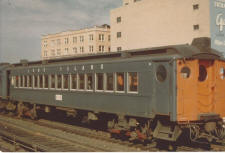 A modernized MP54A1 at the east end of a train at Union Hall Street station in the mid-1960's. |
|||
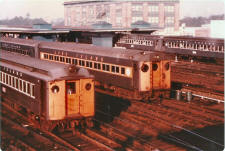 Two eastbound trains leaving Jamaica station, mid-1960's. The one on the left has a MP54A1 at its east end. Archive: Mike Boland |
||||
| MP54A1c | ACF | 9-12/1930 |
4135-4179 ex-MP54A1 1135-1179 Reclassified MP54A1c as automatic speed control (ASC)
apparatus |
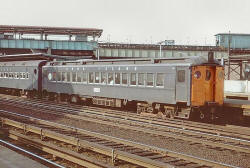 MP54A1c #4153 eastbound passing Woodside on Port Washington track #2 - c.1965 |
|
The
seating capacity was for 69 passengers. These
cars had a special safety feature which was a door interlocking device, or
signal light, indicating to the motorman that the doors are closed.
Each car had train control and had roller bearing trucks. Additional
lights made for better lighting. These
new cars and the conversion of 40 P54D steam cars to control motor
MP54D1's allowed the railroad to run 12-car MU
trains. Its easiest spotting sign are the lack of deck sash and only THREE utility vents along the side of the roof for ventilation. Also, the end door is more recessed, due to improved and thickened collision posts. The cars also had end drip strips above the storm door at the ends of each car. The cars also had two different types of trucks and these were the only cars that arrived with the large, squared-off headlight and destination lights, which were removed later. Some cars had porthole-style side and end doors, while other cars had large, single-pane side and end doors; perhaps this is a clue as to the cars' original builder. Research: Mike Boland |
||||
| MP54B | American Car & Foundry | 1920 |
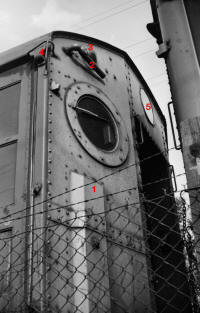 MP54Bc 1972 labeled end: Mike Boland Photo/Archive: Richard Glueck |
|
|
A very rare shot of a MP54Bc end, from the first lot of arch roof control
motors as just about all the arch roof control motor
cars were in the later class
MP54Cc and the converted P54D/MP54D1c cars. 1. The housing for the electro-pneumatic brake system/stand installed by the LIRR in later years, probably in the 1950's. 2. Whistle; these varied in sound with thin types and thick types. 3. Marker lights; replaced destination lights in the modernization program begun in 1954. 4. Side door indicator lights; yellow or red, one color (I"m not sure) indicated CDC, centralized door control. 5. Headlight. This clearly reveals the square ends of an MP54B, later classes had this rounded, giving the engineers a little more space for them to operate. These MP54Bc cars were just too tight and I was told that there was a gentleman's agreement within the LIRR that these cars not be placed at the headend of cars so the engineers would not scrape their hands and knuckles due to a lack of space when operating. Mike Boland |
||||
| The MP54C replaced the MP54B and was one of the largest classes on the
LIRR. Built beginning in 1922 these cars were numbered from #1698-1777 and
then #1784-1943. The gap in numbers was used to number the clerestory roof
ACF-built DC cars bought from the PRR in 1923 or so when AC power took
over. These cars became surplus and the Manhattan Transfer shuttle service
ended. Beginning in December 1954 with MP54C 1742, a great many of these cars were modernized and rebuilt. They retained their original number, but after about 100 cars were rebuilt, a new system of numbering was used with a "4" replacing the "1," as the first number of the car. Ex: Control motor MP54C #1742 became #4742. Note: A small number of these cars were not rebuilt and used as control motors, retaining their original number. All MP54C control motor cars, rebuilt or not rebuilt, had ASC. However, a small number of cars in the 1700-series were never rebuilt, never given ASC and operated as motor trailers in mid-train service. A good number of MP54C cars in the 1700-series were rebuilt as motor trailers. These cars had their headlights, marker lights, wipers, whistles, controls and other gear removed. When rebuilt, these cars originally kept their same numbers, such as #1752, but this car was now without controls so to end/avoid confusion, the railroad replaced the "1" with a "5," denoting a motor trailer. Therefore, this car became #5752 and could be easily identified by LIRR employees; these cars were now classed as MP54CT. Note: This was also done to some class MP54B cars. Research: Mike Boland |
||||
| MP54C | American
Car & Foundry
|
1/23/1922-25, 1927 |
240 cars #1698-1777
control motor cars
|
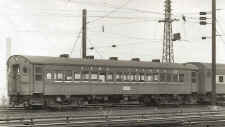 LIRR #4875 MP54C
|
| MP54Cc | American Car & Foundry |
During 1930-42 several cars received 3/2 reversible seating for about 95. Destination lights changed to red-only tail lights after 11/27/1932 after discontinuation of marker light use. Reclassified MP54Bc and MP54Cc as automatic speed control (ASC) apparatus was installed in 1951. Jeff Erlitz |
||
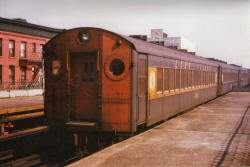 MP54Cc #4929 Nostrand Ave. 3/01/1970 (Grotjahn-Boland) |
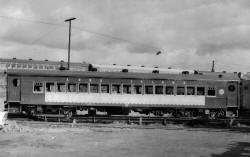 MP54Cc #4793 Richmond Hills c.1960 (Ziel-Boland) |
|||
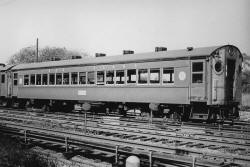 MP54Cc #4824 Archive: Mike Boland |
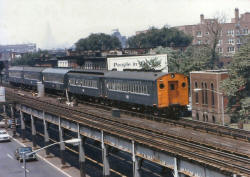 MP54Cc train on Atlantic Ave EL c.1956 (Maywald-Boland) |
|||
| MP54D1 | American Car & Foundry | 7-8/1927 | #1944 to #1983 were converted from class P54D steam cars (Pings) to control motor MP54D1's allowing the railroad to run 12-car MU trains. | |
|
|
||||
| T54 Trailer cars (no motors) which are 39' or 54' long and were placed in trains with a motor car (MP54) at either end. | ||||
| Standard Steel | 1915 | 20 cars 907-926 | ||
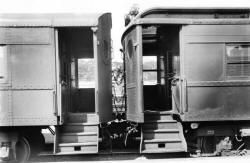 T54 and MP54 at Far Rockaway 9/15/1937 (Ziel-Boland) |
||||
| T54A | #392-421 converted to
multiple-unit trailers, class T54A, in 1925 for the Babylon electrification.
Safety chains replaced diaphragms, underseat electric heating replaced baseboard steam heating, bare bulb DC lights replaced 32v lighting, water cooler, removed, and rattan seats replaced the plush seats in later years. |
|||
| Standard Steel | 5/1917 |
25 cars 927-951 |
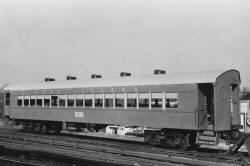 T54A #937 Jamaica 6/14/1952 (Votava-Boland) |
|
| Pressed Steel Corp. | 1917-1/1918 | 45 cars 952-996 |
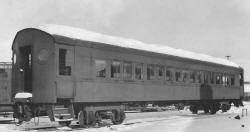 T54A #990 at Morris Park 12/27/1933 (Votava-Boland) |
|
| American Car & Foundry | 7/1920-9/1920 |
50 cars 857-906
|
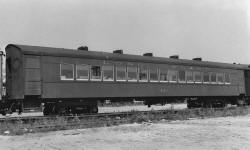 T54A #901 West Hempstead 7/08/1951 (Votava-Boland) 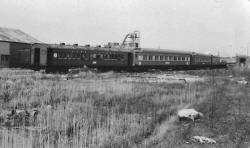 Trailer and parlor cars at Corona Yard being scrapped 1970 Photo/Archive: Mike Boland |
|
| T54B | #422-451 converted to
multiple-unit trailers, class T54B, in 1925 for the Babylon electrification.
Safety chains replaced diaphragms, underseat electric heating replaced baseboard steam heating, bare bulb DC lights replaced 32v lighting, water cooler, removed, and rattan seats replaced the plush seats in later years. |
|||
| American Car & Foundry | 1921-6/1923 |
#425,428-431 modernized to #6425, 6428-6431
|
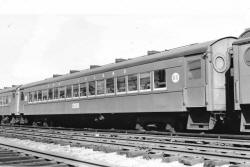 Modernized T54B #6431, probably Babylon Yard early 1960's (Votava-Boland) |
|
|
|
||||
| MOTORIZED TRAILERS | ||||
| The "T" suffix at the end of some classes, such as MP54T, MP54AT, MP54BT and MP54CT,
meant the car, originally a headend car equipped with engineer's controls, had them removed
along with whistle, wiper, headlights, etc. and converted to mid-train use as a motor, motorized or blind
motor. This meant the car could NOT be at either end of an MU train. The equipment taken from the cars went into stock used for other MU cars that were equipped with Automatic Speed Control (ASC) and used at headend cars when the State of New York forced the railroad to operated with this feature following the two big 1950 crashes with much loss of life. About half of the fleet of MU cars received ASC, the remainder did not. This was a big savings of money; in fact, the LIRR was so broke that the PRR and New York State paid for the installation of ASC. This was a new class of car; as until this time, the railroad had only control motor cars and trailers, but after 1951 this all changed. Not until 1953 and 1955, did the railroad buy new motor trailer cars, specifically built as such by Pullman-Standard. Many control motor cars ran in trains and did not have ASC and thus used in mid-train service, even though they specifically were NOT converted to motor trailers. With the car rehabilitation program in 1955, these cars eventually had their controls removed and were renumbered and rebuilt into the 5000-series of cars. What I like about the LIRR is that there were always exceptions and a number of cars in the 1700-series of arch motors never were converted, and had never been given ASC. They were considered motor trailers even though they were not converted, and in later years their class was changed to indicate they were a motor trailer even when they were not in the shops to have the conversion. A car like this was arch roof 1776, a great number for the Bicentennial. Research: Mike Boland |
||||
| MP54T | American Car & Foundry | 1908 |
Part of the first MP54s on the LIRR, it was converted to a motor trailer
with the same car number. Perhaps the shops got lazy or forgot to removed the headlights.
|
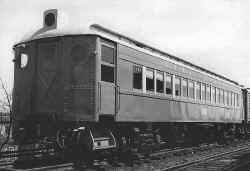 MP54AT #1520 at Richmond Hill 4/16/1950 (Votava-Boland)
|
|
|
||||
| MOTORIZED/COMBINE | BUILDER | DATES | DATA | |
| MPB54 |
1910
-1914
#1350-1381 |
At the Dunton Car Shop combine MPB54
#1379 had the passenger end of the car photographed on November 9, 1933. There were subtle differences in the end details of headend MU cars. Note the large scissors-like apparatus that operated the doors at this time; also note the cowcatcher or pilot behind the coupler and in front of the trucks, removed in the 1950's with the advent of speed control. Collection of Ron Ziel. |
LIRR MPB54 #4398 (ex-#1398) in Dashing Dan scheme at Woodside Station 06/10/1969
|
|
| MPB54c | American Car & Foundry | 8/1913-5/1914 #4370-4398 |
||
| MPBM54 | American Car & Foundry | 1913 #1382-1384 |
 MPBM54 RPO Combine #1382-1384 Diagram 10/2014 by Gerry O'Regan Archive: George Chiasson, Jr. |
|
|
|
||||
| MOTORIZED/BAGGAGE | BUILDER | DATES | DATA | |
| MB62 | American Car & Foundry | 1910 #1205-1219 |
|
|
|
|
||||
| MOTORIZED/BAGGAGE/MAIL | BUILDER | DATES | DATA | |
| The first car is one of two MU motor baggage mail cars, class MBM62 1209 and 1210 that were originally
ACF in 1925 to have a mail compartment constructed at one end of the car.
Some time later a small engineer's compartment door was added to the right side of the car on one side only,
the side that had a 6-foot baggage door on the left. Remember, the other side of the car has the mail
compartment, but the baggage end has double sliding doors that are about 8-feet wide.
Look for the mail compartment on the two MBM62's, and that will tell you whether it's a MBM62 or a straight MB62. The MB62's have two windows between the doors and a small window at each end of the car. It's a different look for the MBM62's, a fascinating car and almost as unique as the second car in this consist, an MPBM54. The second car is a Motorized Passenger Baggage Mail MPBM5 car and both sides of the car are a little different in the
baggage-mail area. Baggage-mail MU's were 1205-1219, although 1215 and up were used as diesel cars, with 1217-1219 running all their
years as steam/diesel cars. |
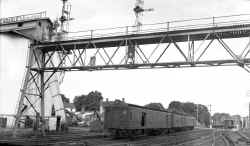 MU Express Mail train at Babylon: MBM62, MPBM54, MPB54 taken from the high platform at the Babylon freight house just west of Carll Avenue. ViewNE. (Votava-Keller)
|
|||
| MBM62 | American Car & Foundry | 1910 | 1209-1210 Mail compartments removed after 1963
|
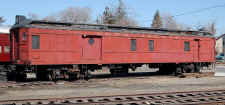 MBM62 RPO RMLI Riverhead View NE 2/09/2006 Photo: Peter Cusden
|
| MBM62c | ACF | 8/1910 |
MBM62's
4209-4210 were originally Since these cars had, on each side, a double baggage door of 8 feet at the left and a single 6-foot door, the other side of the car--the one that is shown in this photo--is the rarely seen 8-foot double-door side. 1209 was modernized in February 1960, becoming 4209;1210 was modernized in June 1960, becoming 4210. When USPS RPO service ended in 1965, most RPO cars were scrapped but these two cars were used from July 1965 to July 1969 around Dunton to act as goats and move dead MU cars around between the shops, nearby Johnson Avenue Yard and Yard D on the other side (north) of Jamaica station where MU trains were put together, broken up and stored. Research: Mike Boland |
 MBM62c RPO #4209 Morris Park 1969 Photo/Archive: Richard Glueck |
|
|
||||
|
BG72B |
Pullman Standard | 1955-56 | Nos.
2101-2104 Bar Generator Cars
|
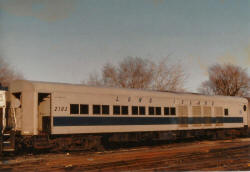 Bar generator car #2102 - Oyster Bay c.1980+ (Maywald-Boland)
|
| B60B | American Car & Foundry | 8/1928 | 715-724 1928 PRR 718 rebuilt to wreck train car W-56. 723 has been preserved modernized 12/1955 and renumbered #7723. Withdrawn from service 1970. | 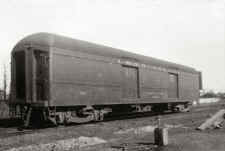 B60B #723 Archive: Jeff Erlitz |
| BM60 | American Car & Foundry | 12/1928 | 737 Mail compartment added in late
forties, class changed to BM60 Modernized 3/1957 renumbered 7737 converted
to a wreck train car W-57, 4/1966. Donated to Railroad Museum of Long Island
(RMLI), Riverhead, NY, 1/23/1993
|
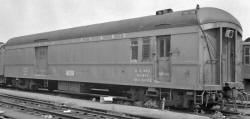 RPO car #737 has been photographed at the storage yard in |
|
MP41 |
American Car & Foundry | 1905 | Nos.
1000-1133 first class of MU electric cars, 41'
interior
|
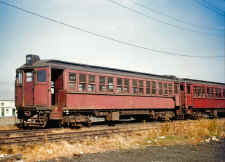 LIRR MP41 #1111 Rockaway Park Yard 1948 (Rugen-Huneke) |
| Gibb's Cars | 1905 | BRT/LIRR operations; see below | 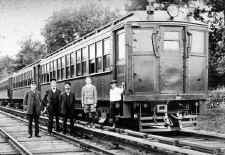 LIRR/BRT MP41 "Gibbs Car" c.1908 Archive: Dave Keller |
|
|
This
was a BRT-style coupler, as these MP41 cars were built to run in joint
LIRR/BRT operation (which ended in 1917) and were even nicknamed
"Gibbs Cars" after the guy who designed the similar electric
passenger cars for the BRT. After purchasing a bunch of these cars
in 1905 for operation in newly-electrified territory, the LIRR purchased
new MP54 cars in 1909-10. The shorter, MP41 cars were eventually
relegated to rapid-transit service along the Atlantic branch and the
longer and newer MP54 cars were used in the rest of electrified
territory. I've never seen the coupler pushed over to one side
like that. MU Cars in Mitchel Field Shuttle Service |
||||
|
|
||||
| MP72C | Pullman Standard | 1955 | Nos. 2501-2522
|
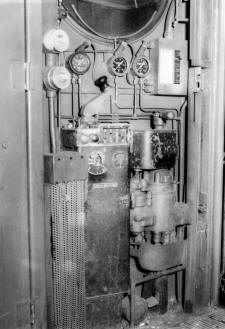 MP72C engineer control stand c.1958 Archive: Mike Boland |
| MP75C | Pullman Standard | 1963 | Nos.
2525-2536 Converted to control trailers 5525-5536 Note: MP75 "ZIP" cars did NOT have portholes at their ends; instead, a single square window to match the end and side doors.
|
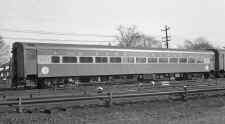 LIRR #2534 MP75C Zip car control motor ex-World's Fair logo repaint - West Hempstead 1/20/68 (Votava-Keller) 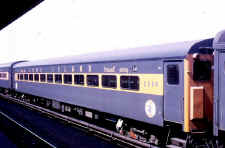 LIRR #2536 MP75C Jamaica 1969 Archive: Dave Keller |
| MP72T | Pullman Standard | 1955-1956 | Nos. 2602-2674 Converted to PT72C, PP72B (#2011-2021) and BG72B | |
| MP75T | Pullman Standard | 8/1963 | Nos.
2675-2692
Converted to trailers 5675-5692
By mid-August 1963, 15 Zip cars were on
their |
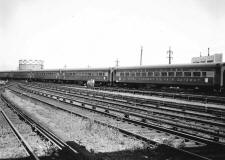 MP75T's arriving at Dunton 8/1963 (Gene Collora-Mike Boland)
|
|
|
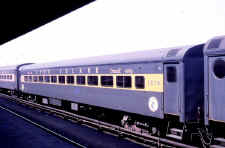 LIRR #2679 MP-75T Jamaica 1969 Archive: Dave Keller |
|||
| PP72B | Pullman Standard | 1955-56 | Nos. 2011-2021 Push-pull Parlors were rebuilt former MU trailer cars (Class MP72T) converted to diesel-hauled push-pull service. |
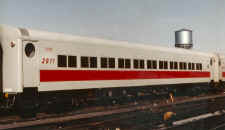 Parlor #2011 (John Scala - Mike Boland) |
| PT72 Bar | Pullman Standard | 1955-56 | 2890,
2892, 2894 Tentative: 2829 and 2833 But only 2833, being used almost exclusively in push-pull parlor service, got the red stripe. |
|
| PT72C | Pullman Standard | 1955-56 |
2846-2898 Even Nos. only plus 2792, 2794, 2796 |
|
| PT75 | Pullman Standard | 1963 | 2701-2723 odd #’s | |
| PT75A | Pullman Standard | 1963 |
2702-2736
Even #’s only |
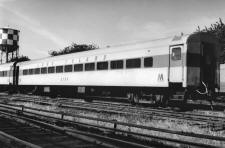 PT75A #2706 Push-Pull coach - ex-MP75T 9/30/1973 Photo: George Votava Archive: Mike Boland |
| PT74 Bar | Pullman Standard | 1963 | 2705 | |
| T72 | Pullman Standard | 10-12/1955 | 2801-2844 |
 T72 #2837 World's Fair scheme - Jamaica 1966 Archive: Bob Earle |
| GTEL | Budd/GE/Garrett | 1977-? | 8 cars purchased | |
| Gas Turbine Power trains | 4 GE/ & 4 Garrett GE’s
converted to M-1s |
|||
| M1 | Budd | 1968-1972 | 770
cars first run 12/30/1968 Retired 2/2007 Nos. 9001-9770
Cars #9001-9016 built 1968 |
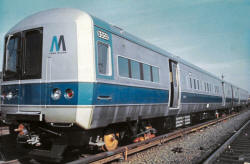 LIRR #9002 Budd M1 public relations 8"x10" photo release. Archive: Gary Doster |
| M3 | Budd | 1984-1986 | 174 cars phased in
1985-86 Nos.#9771-9944 Renumbered 9891-2 to 9945-6 after
the LIRR massacre (12/07/1993 at the Merillon Avenue
station in Garden City). M3's back in service: ??
|
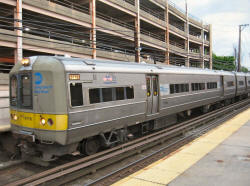 M3 #9779 eastbound Mineola - View SW 2007 c.2008 Photo/Archive: Gary Chatterton |
| M7 | Bombardier | 1999-2006 |
836 cars purchased #7001-7836
|
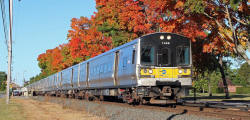 M7 #7466 - Eastbound at Pinelawn |
| M9 | Kawasaki Heavy Industries | 2017- | 202
cars, 92 cars in the original order had been conditionally accepted. The
LIRR also exercised an option for 110 additional cars in July 2017.
Entered into passenger service September
11, 2019. |
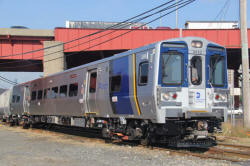 M9 #9002 first run LI City 9/11/2019 Photo/Archive: Jose Garrido Alonzo |
|
|
||||
| SCRAP | ||||
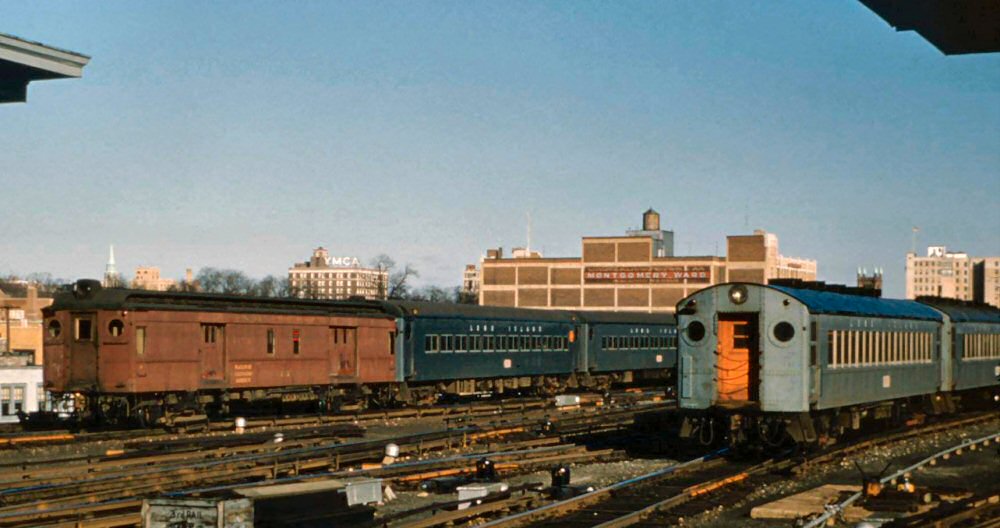
_small.jpg)
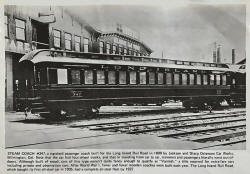
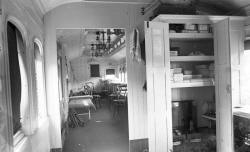
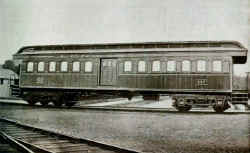

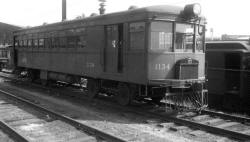
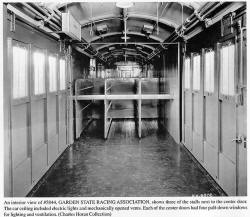

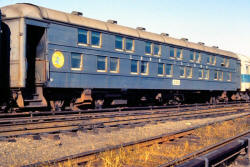
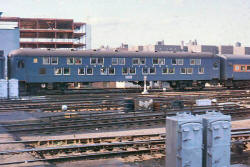
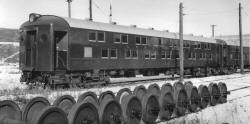
_5-23-1947_JeffErlitz_small.jpg)
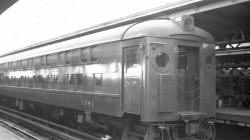
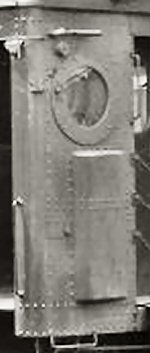
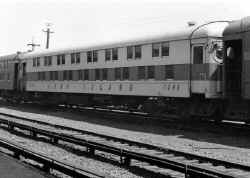
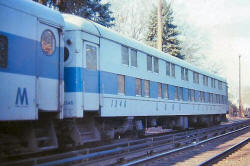
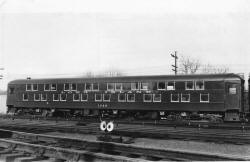
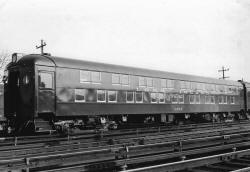
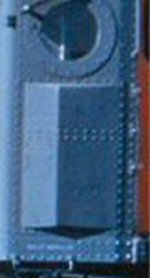
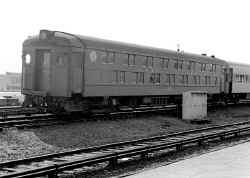
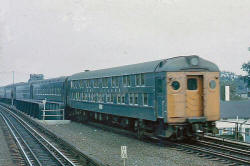
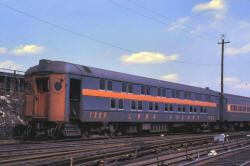
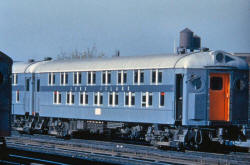
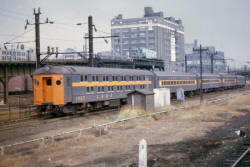

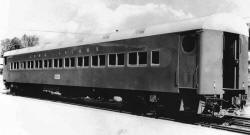
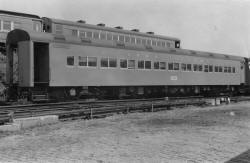
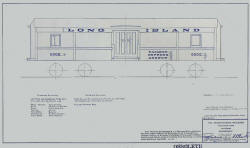
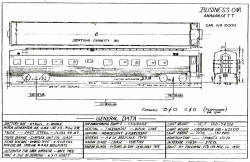
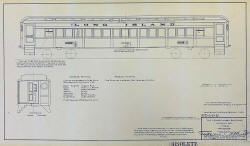
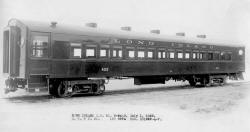
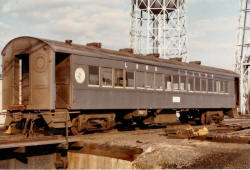
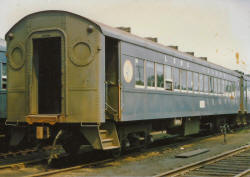
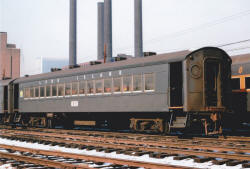
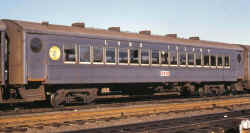
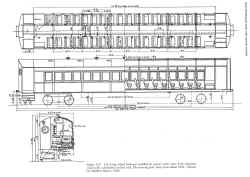
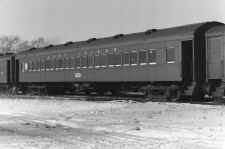
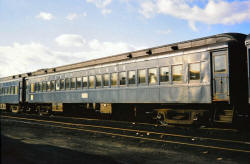
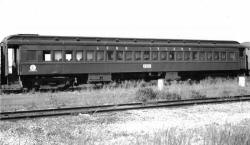
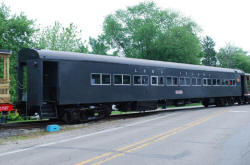
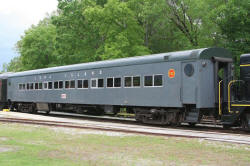
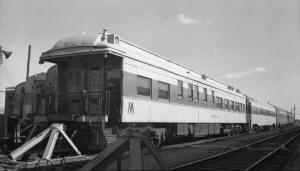
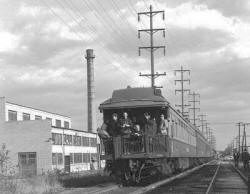
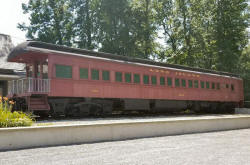
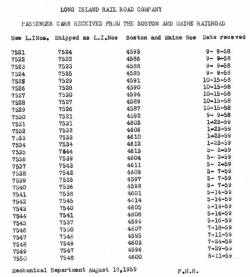
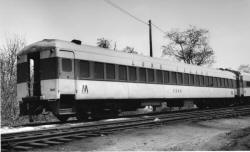
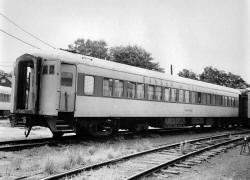
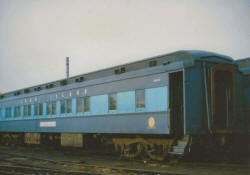
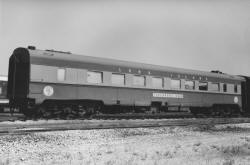
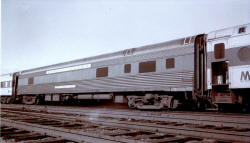
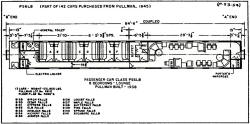
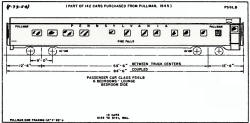
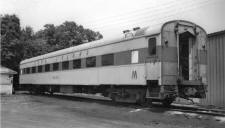
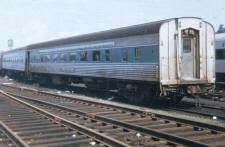
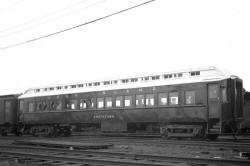
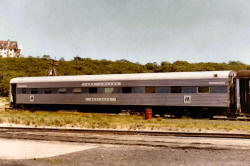





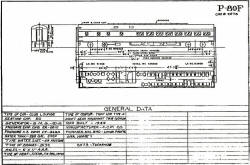
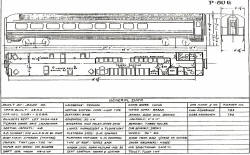
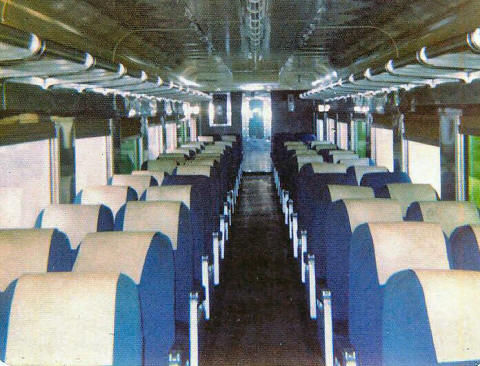
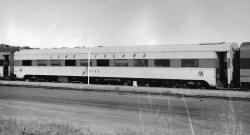
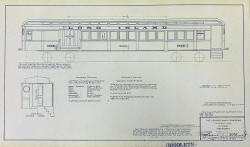
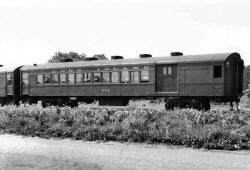
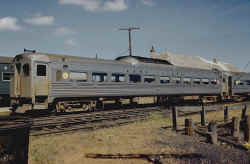
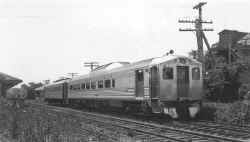
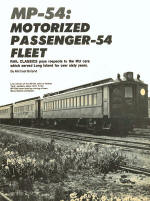
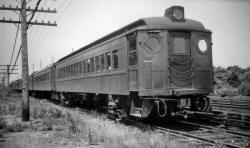
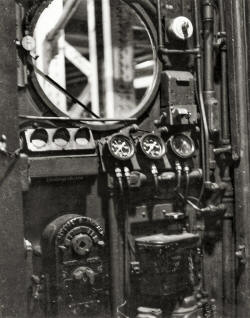
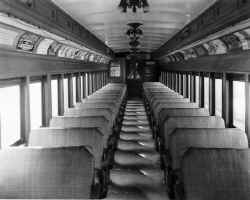
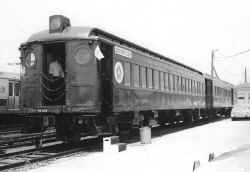
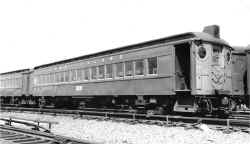
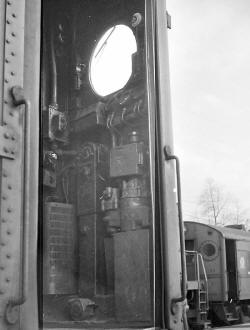
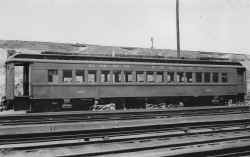
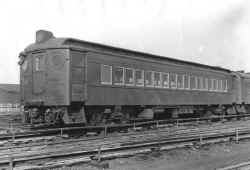
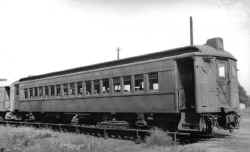
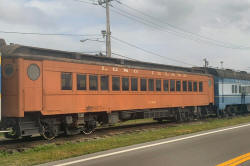
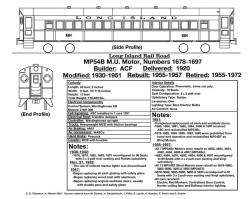
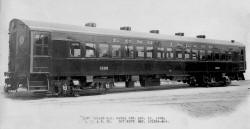
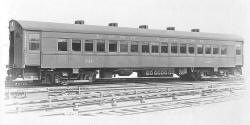
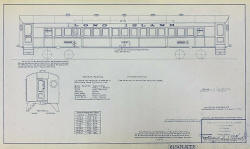
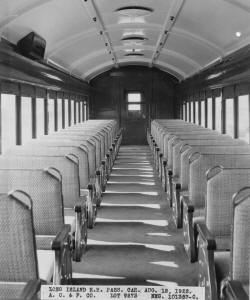
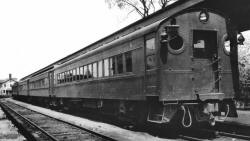
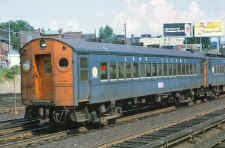
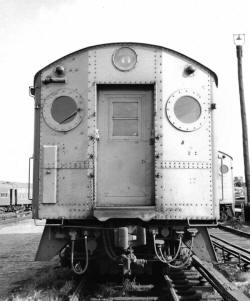
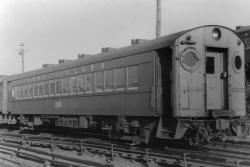
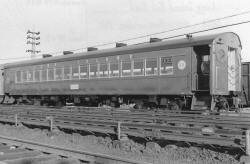
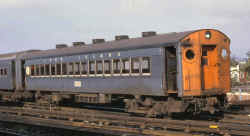
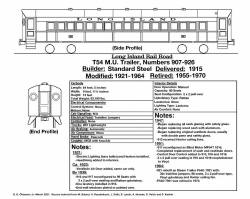
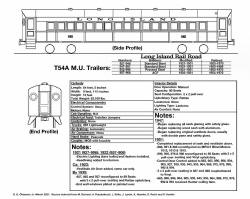
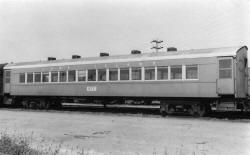
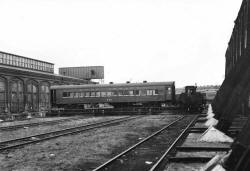
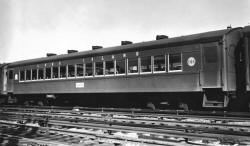
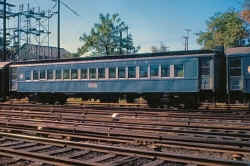
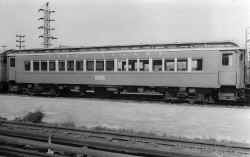
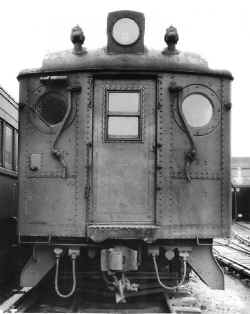
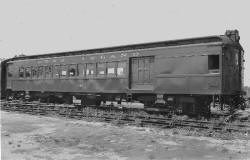
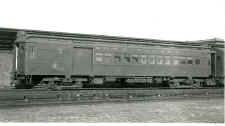
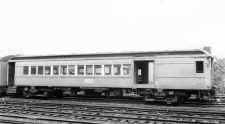
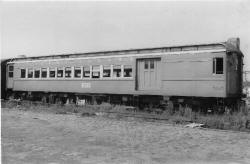
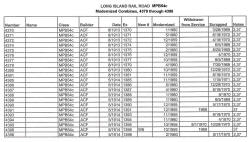
_small.jpg)
%20-%20Altoona%20Shops-04-13-1931-eBay_small.jpg)
